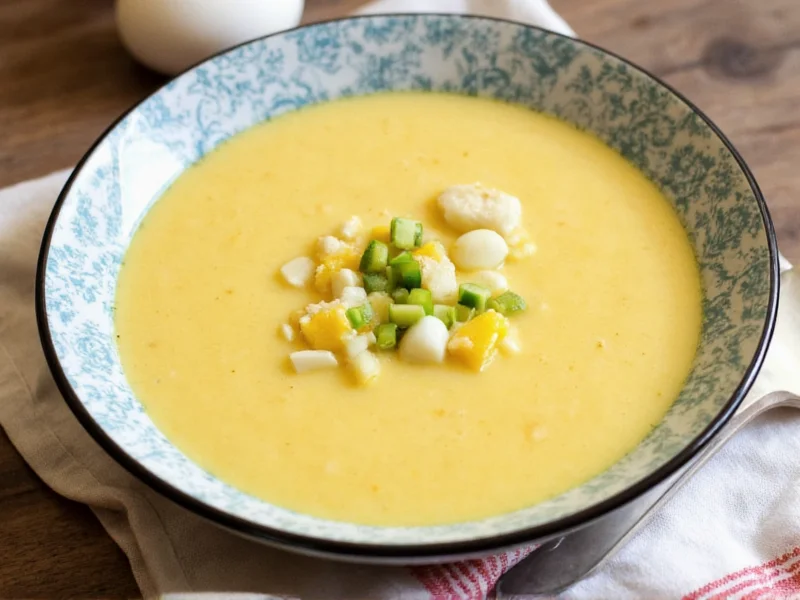Mastering the Simplest Egg Flower Soup
Egg flower soup, known as dan hua tang in Chinese cuisine, represents one of the most accessible entry points into Chinese cooking. This classic comfort food transforms humble ingredients into a silky, satisfying broth that’s perfect for weeknight dinners or when you’re feeling under the weather. What makes this particular version exceptionally easy is its streamlined ingredient list and elimination of complicated techniques that often intimidate beginners.
Why This Easy Egg Flower Soup Recipe Works
The magic of authentic egg flower soup lies in the delicate ribbons of cooked egg suspended in clear broth. Many home cooks struggle with achieving that signature texture, resulting in either scrambled eggs or thin, watery soup. Our simplified approach solves these common problems through three key innovations:
- Cornstarch integration – Adding a small amount directly to the eggs creates perfect suspension without clouding the broth
- Temperature control – Maintaining broth just below simmering point prevents egg curdling
- Gradual incorporation – The slow pour technique creates those beautiful “flower” patterns
Essential Ingredients for Foolproof Egg Flower Soup
Unlike complex restaurant versions, this beginner-friendly recipe requires only pantry staples. Here’s what you need for two generous servings:
| Ingredient | Amount | Why It Matters |
|---|---|---|
| Low-sodium chicken broth | 4 cups | Provides clean base flavor without overpowering saltiness |
| Large eggs | 2 | Fresher eggs create more defined “flower” patterns |
| Cornstarch | 1 tbsp | Creates perfect egg suspension without thickening broth |
| Soy sauce | 1 tsp | Adds umami depth without clouding the broth |
| Sesame oil | 1/2 tsp | Provides authentic finishing aroma |
| Green onions | 2 tbsp, sliced | Adds freshness and visual appeal |
Step-by-Step Preparation Guide
Follow these straightforward instructions for perfect egg flower soup every time. The entire process takes just 15 minutes from start to serving.
- Prepare the egg mixture – In a small bowl, whisk 2 eggs with 1 tablespoon cornstarch and a pinch of salt until completely smooth. This cornstarch trick prevents the common beginner mistake of scrambled eggs.
- Heat the broth – Pour 4 cups of chicken broth into a medium saucepan. Bring to just below simmering point (look for small bubbles forming around the edges but not a rolling boil). High heat creates scrambled eggs rather than delicate ribbons.
- Add seasonings – Stir in 1 teaspoon soy sauce and any additional seasonings you prefer. Avoid adding salt directly as soy sauce provides sufficient sodium.
- Create the egg flowers – Reduce heat to low. Slowly pour the egg mixture into the broth in a thin, steady stream while gently stirring the broth in one direction. The egg should form beautiful ribbons as it cooks instantly upon contact.
- Finish and serve – Remove from heat immediately once all egg is added. Stir in 1/2 teaspoon sesame oil and 2 tablespoons sliced green onions. Serve hot in pre-warmed bowls.
Avoiding Common Beginner Mistakes
Even the simplest egg flower soup recipe can go wrong without proper technique. These troubleshooting tips ensure success:
- Don’t boil the broth – Vigorous boiling breaks the delicate egg ribbons into small pieces. Maintain temperature just below simmering (180-190°F)
- Whisk eggs thoroughly – Any unincorporated egg white will create uneven texture in your soup
- Pour slowly while stirring – A steady, thin stream with continuous gentle stirring creates the signature flower pattern
- Add eggs off direct heat – Remove broth from burner before adding eggs for maximum control
Simple Variations for Customization
Once you’ve mastered the basic easy egg flower soup recipe, try these accessible modifications:
- Vegan version – Substitute vegetable broth and replace eggs with 1/4 cup silken tofu blended until smooth
- Protein boost – Add 1/4 cup shredded cooked chicken or tofu cubes before pouring in the egg mixture
- Vegetable enhancement – Stir in 1/4 cup finely diced mushrooms or bamboo shoots during broth heating
- Spicy kick – Add 1/4 teaspoon white pepper or a few drops of chili oil before serving
Serving and Storage Recommendations
Egg flower soup tastes best when served immediately after preparation. For optimal presentation:
- Use wide, shallow bowls to showcase the delicate egg ribbons
- Garnish with additional sliced green onions and a tiny drizzle of sesame oil
- Pair with steamed rice and simple stir-fried vegetables for a complete meal
While egg flower soup doesn’t store exceptionally well due to the delicate egg texture, leftovers can be refrigerated in an airtight container for up to 2 days. Reheat gently on the stove over low heat without boiling to prevent further egg cooking. The soup may thicken slightly upon standing – simply add a splash of broth or water when reheating.
Why This Recipe Stands Out Among Easy Egg Flower Soup Options
Many simplified egg flower soup recipes sacrifice authenticity for convenience, resulting in either scrambled eggs in broth or overly thickened versions that miss the mark. This particular approach preserves the essential characteristics of traditional Chinese egg flower soup while eliminating unnecessary complications.
The strategic use of minimal cornstarch in the egg mixture rather than the broth maintains crystal-clear appearance while ensuring perfect egg suspension. By focusing on temperature control and pouring technique rather than exotic ingredients, this recipe delivers authentic results with maximum accessibility for home cooks of all skill levels.











 浙公网安备
33010002000092号
浙公网安备
33010002000092号 浙B2-20120091-4
浙B2-20120091-4